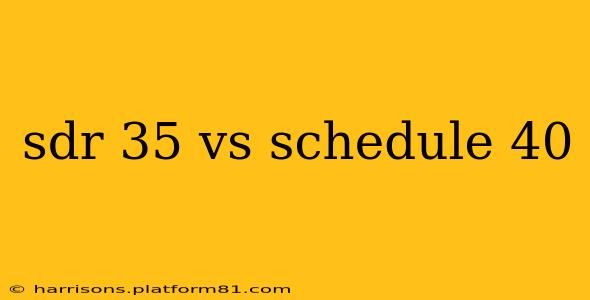SDR 35 vs. Schedule 40 Pipe: A Comprehensive Comparison
Choosing the right type of pipe for your project can be crucial for its success and longevity. Two common choices are SDR 35 and Schedule 40 pipes, both frequently used in various applications. Understanding their key differences is vital for making an informed decision. This comprehensive guide will delve into the specifics of SDR 35 and Schedule 40 pipes, highlighting their strengths and weaknesses to help you choose the best fit for your needs.
What is SDR 35 Pipe?
SDR 35 pipe, short for Standard Dimension Ratio 35, is a type of plastic pipe, often made from polyethylene (PE) or polyvinyl chloride (PVC). The "SDR" designation refers to a ratio that dictates the pipe's wall thickness relative to its outside diameter. A lower SDR number indicates a thicker wall, signifying higher pressure resistance. Therefore, SDR 35 pipes offer a balance between strength and flexibility.
What is Schedule 40 Pipe?
Schedule 40 pipe is typically made of steel, but can also be found in other materials like PVC. The "Schedule" designation refers to a standardized system that dictates the pipe's wall thickness. Schedule 40 pipes are known for their robust construction and higher pressure resistance compared to many other pipe types. They are frequently employed in applications demanding significant strength and durability.
Key Differences: SDR 35 vs. Schedule 40
| Feature | SDR 35 | Schedule 40 |
|---|---|---|
| Material | Typically PVC or PE | Typically steel, but also PVC available |
| Wall Thickness | Thinner compared to Schedule 40 | Thicker compared to SDR 35 |
| Pressure Rating | Lower compared to Schedule 40 | Higher compared to SDR 35 |
| Flexibility | More flexible | Less flexible |
| Cost | Generally less expensive | Generally more expensive |
| Applications | Irrigation, drainage, low-pressure water lines | High-pressure water lines, gas lines, industrial applications |
| Corrosion Resistance | Excellent | Can be susceptible to corrosion (steel) |
| Durability | Good, but less durable than Schedule 40 in demanding applications | High, especially in steel variants. |
What are the advantages and disadvantages of SDR 35 pipe?
Advantages:
- Cost-effective: SDR 35 pipes are generally cheaper than Schedule 40 pipes.
- Flexible: Their flexibility makes them easier to install in challenging terrains.
- Corrosion resistant: Plastic SDR 35 pipes are highly resistant to corrosion.
Disadvantages:
- Lower pressure rating: Not suitable for high-pressure applications.
- Lower durability: Less durable than Schedule 40 pipes, especially in demanding conditions.
What are the advantages and disadvantages of Schedule 40 pipe?
Advantages:
- High pressure rating: Suitable for high-pressure applications.
- High durability: Withstands significant pressure and wear.
- Strength: Robust construction ensures structural integrity.
Disadvantages:
- Higher cost: More expensive than SDR 35 pipes.
- Less flexible: Can be more difficult to install in complex layouts.
- Susceptible to corrosion (steel): Steel Schedule 40 pipes can corrode over time, requiring protective measures.
What type of pipe is best for water lines?
The best type of pipe for water lines depends on several factors, including the water pressure, the application (domestic, industrial), and the budget. For low-pressure applications like irrigation or residential water lines with lower pressure, SDR 35 PVC pipe might suffice due to its cost-effectiveness and ease of installation. For higher-pressure applications or industrial settings, Schedule 40 pipes (either steel or PVC) are generally preferred for their superior strength and pressure resistance.
What is the difference between SDR and Schedule?
SDR (Standard Dimension Ratio) and Schedule are different rating systems used to classify pipes based on their wall thickness. SDR is primarily used for plastic pipes, where the ratio between the outside diameter and the wall thickness determines the pressure rating. Schedule is a system used for metal and some plastic pipes, directly specifying the wall thickness, which in turn dictates the pressure rating. They are not directly comparable—you can't simply equate an SDR value to a Schedule value. Each system has its own set of standards and pressure ratings.
Which pipe is better for underground use?
For underground applications, factors such as soil conditions, potential for ground movement, and the pressure of the fluid being transported are key considerations. In many cases, the higher strength and durability of Schedule 40 pipe make it a more suitable choice for underground use, especially in areas with heavy traffic or unstable soil. However, the flexibility of SDR 35 pipe can be advantageous in situations where the ground might shift or settle. The best choice ultimately depends on a thorough assessment of the specific site conditions.
This detailed comparison should help you determine whether SDR 35 or Schedule 40 pipe is the right choice for your project. Remember to always consult with a qualified professional for specific applications and to ensure compliance with all relevant building codes and regulations.
